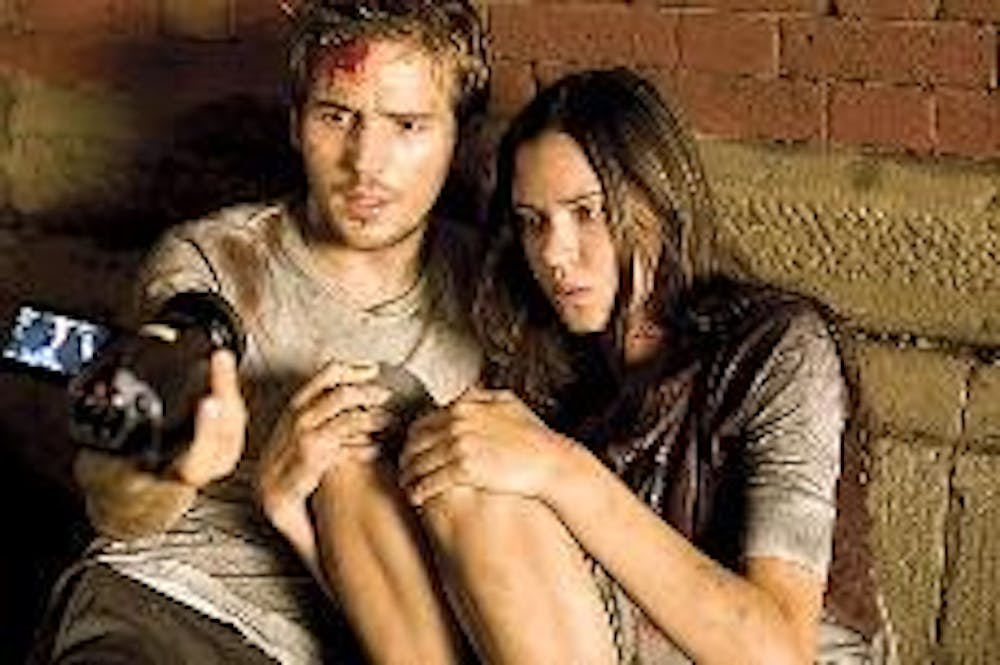"Cloverfield," the much-hyped monster movie produced by "Lost" creator J.J. Abrams, is one horrific vision of things falling apart - not simply because an unidentified monster is destroying New York City right before our heroes' eyes, but also because the film's director, Matt Reeves, destroys the film's provocative concept right before the audience's eyes.
Just imagine how interesting this film must have sounded to executives when Abrams pitched it: "Cloverfield" - it's like "The Blair Witch Project" meets a Godzilla movie. Some friends are throwing a going-away party for Rob (Michael Stahl-David), who will soon be leaving New York to live in Japan. They want to document the event, so Rob's brother (Mike Vogul) brings along a video camera. A monster begins attacking the city moments after the party has started, and this video camera serves as the audience's eye into the chaos.
The obscured perspective also makes "Cloverfield" something of a throwback to older thrillers like "Jaws" and "Alien," in which scares are not based on how much gore is visible on screen, but on how little the audience sees the monster. The fear of these films is, of course, based on the unknown. The reasons for presenting "Cloverfield" from the fleeing civilian's perspective become clear: Not only does it foster suspense, but it also continues the knowing-less-is-fearing-more philosophy of 1970s thrillers.
For this approach, "Cloverfield" should be commended. Very few contemporary horror and thriller directors understand the importance of building tension. However, true tension is the very basis for fear in film. The payoff moment, the scene in which someone is killed or the monster attacks, diffuses that tension.
Reeves revels in these suspenseful moments, never hurrying along to that chaotic payoff moment. The party sequence opening the film exemplifies this intention, weaving character-development amid audience expectation. When will the monster attack? By the time it does, the audience is startled because it have since shifted focus from awaiting the footage previewed in the film's trailer to awaiting the outcome of a tempestuous relationship.
Where Reeves fails is in how he conducts the film's aesthetic and in how he doesn't communicate with cinematographer Michael Bonvillain. The camera work is so unforgivably jittery that many audience members may quickly find themselves severely nauseated. Yes, the "Blair Witch"-inspired cinematography is essential to achieving Abrams' monster-movie plan. But instead of simply lifting "The Blair Witch"-camera method, Bonvillain should have employed a steadicam that allowed for enough shakiness to sell the film's premise and enough control to avoid churning moviegoers' stomachs.
That the camera work mars the "Cloverfield" theater experience so much is a minor tragedy. The film presents so many interesting ideas, including social commentary on youth swept up in the digital age, that it's a shame most moviegoers will be feeling too sick to enjoy it. One of the most insightful sequences comes when the monster tosses the Statue of Liberty's head down a New York street. People scatter at first. Many scream; most pull out their camera phones to snap pictures.
Is this what people are most concerned about when tragedy strikes? Documenting these events and throwing videos up on YouTube?
Though "Cloverfield" is sure to suffer on the movie-theater screen, it may enjoy success on DVD. Viewing the shaky camera work on such a big screen is certainly what contributes to the feelings of nausea. On a television, however, the film might communicate more effectively. And if it does, it will be an ironic triumph - that a movie commenting on society's need to create and consume disposable digital media would be best viewed on a home entertainment device.





